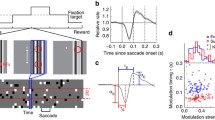Summary
Visual evoked responses to sinusoidal movement before and after adaptation to linear movement were compared. Fourier analysis indicated that the responses evoked by sinusoidal movement were insensitive to direction of movement. Following adaptation, the harmonics describing the waveforms changed in magnitude and phase, and showed an asymmetry of waveshape not evident before adaptation. The data are consistent with the existence of movement-sensitive cells within the intact visual system which change in response characteristics as a result of adaptation to linear movement.
Similar content being viewed by others
References
Addams, R.: An account of a peculiar optical phaenomenon. Philosoph. Mag. 5, 373–374 (1834)
Armington, J.C.: Adaptational changes in the human electroretinogram and occipital response. Vision Res, 4, 179–192 (1963)
Barlow, H.B., Hill, R.M.: Evidence for a physiological explanation of the waterfall phenomenon and figural aftereffects. Nature (Lond.) 200, 1345–1347 (1963)
Chase, R., Kalil, R.: Suppression of visual evoked responses to flashes and pattern shifts during voluntary saccades. Vision Res. 12, 215–220 (1972)
Clarke, P.G.H.: Visual evoked potentials to sudden reversals of the motion of a pattern. Brain Res. 36, 453–458 (1972)
Cynader, M., Berman, N.: Receptive field organization of monkeys superior colliculus. J. Neurophysiol. 35, 187–201 (1972)
Day, R.H., Strelow, E.: Reduction or disappearance of visual aftereffect of movement in the absence of patterned surround. Nature (Lond.) 230, 55–56 (1971)
Erke, H., Graser, H.: Reversibility of perceived motion: selective adaptation of the human visual system to speed, size, and orientation. Vision Res. 12, 69–87 (1972)
Goldberg, M.E., Wurtz, R.H.: Activity of the superior colliculus in behaving monkeys. I. Visual receptive fields of single neurons. J. Neurophysiol. 35, 542–559 (1972)
Hubel, D.H., Wiesel, T.N.: Receptive fields and functional architecture of the monkey's striate cortex. J. Physiol. (Lond.) 195, 215–243 (1968)
MacKay, D.M., Rietveld, W.J.: Electroencephalogram potentials evoked by accelerated visual motion. Nature (Lond.) 217, 677–678 (1968)
Pantle, A., Sekuler, R.: Contrast of human visual mechanism sensitive to orientation and direction of motion. Vision Res. 9, 397–405 (1969)
Purkinje, J.: Beobachtungen und Versuche zur Physiologie der Sinne. Bd. II, Berlin: G. Reimer 1825
Regan, D., Beverley, K.I.: The dissociation of sideways movements from movements in depth: psychophysics. Vision Res. 13, 2403–2415 (1973)
Ruchkin, D.S., Villegas, J., John, E.R.: Analysis of average evoked potentials making use of the least mean square techniques. Ann. N.Y. Acad. Sci. 115, 799–826 (1964)
Sekuler, R.W., Ganz, L.: Aftereffect of seen motion with a stabilized retinal image. Science 139, 419–420 (1963)
Spekreijse, H., Tweel, L.H. van der, Regan, D.: Interocular sustained suppression: correlation with evoked potential amplitude and distribution. Vision Res. 12, 521–526 (1972)
Spinelli, P.N., Pribram, K.H., Bridgeman, B.: Visual receptive field organization of single units in the visual cortex of monkeys. Int. J. Neurosci. 1, 67–74 (1970)
Tyler, C.W., Torres, J.: Frequency response characteristics for sinusoidal movement in the fovea and periphery. Perc. and Psychophys. 12 (2B), 232–236 (1972)
Author information
Authors and Affiliations
Rights and permissions
About this article
Cite this article
Tyler, C.W., Kaitz, M. Movement adaptation in the visual evoked response. Exp Brain Res 27, 203–209 (1977). https://doi.org/10.1007/BF00237698
Received:
Revised:
Issue Date:
DOI: https://doi.org/10.1007/BF00237698




